 |
||
|
||
| ||
TDK CyClone AI-241040
Ricoh MP7200A shined in speed tests not for a long time. First it was pressed by Yamaha CRW2200E which took the same level with the leader. After that both companies were moved down to the second position by TDK whose aggressive policy is built so that take dominating positions not only in the field of storage media, but also on the market of CD-RW drives. So, the new model from TDK - CyClone AI-241040 - has a series of new technologies and enhancements which allow us to announce a new stage in the development of optical systems of data storage. 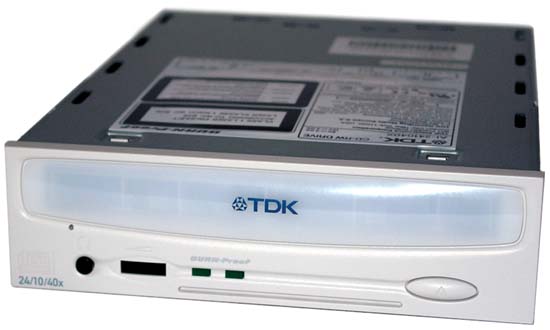
The device ships in a Retail package. The box contains:
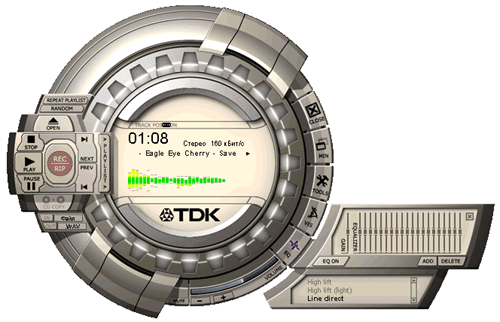 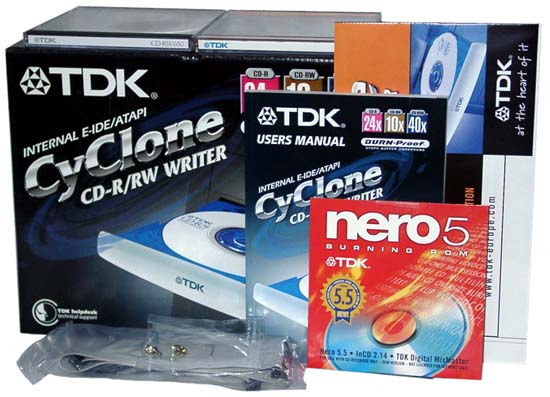  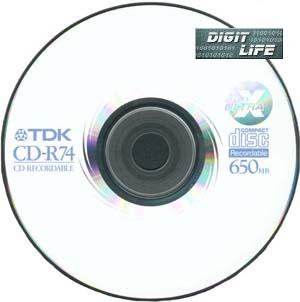 ATIP: 97m 24s 01f 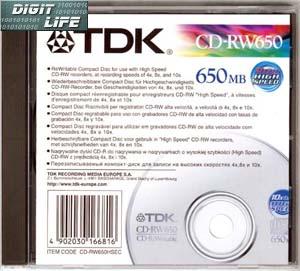 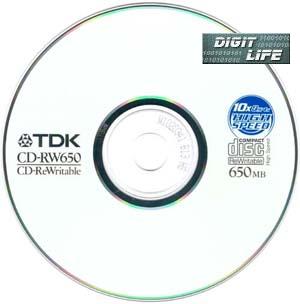 ATIP: 97m 27s 10f The CyClone 241040 supports such modern technologies as Zone-CLV and FlexSS-BP. Zone-CLV (Zone Constant Linear Velocity) is a method when the whole disc is divided into three fields which are burnt at definite speeds: they are constantly growing from 16X to 20X and then to 24x. At this moment the BURN-Proof technology is activated to change the speed. FlexSS-BP - the term FlexSS-BP is composed of word-combinations "Flexible Speed" and "Flexible Strategy". The FlexSS-BP technology from Sanyo is similar to JustSpeed from Ricoh. It estimates quality of a disc, its adequacy for high-speed recording (20X and 24X). But Sanyo says its solution is more perfect since the JustSpeed can estimate an optimal recording speed only at the beginning of recording. The FlexSS-BP technology can control the state of a disc and correct the recording process at any moment. According to Nero the CyClone has the following technical possibilities: 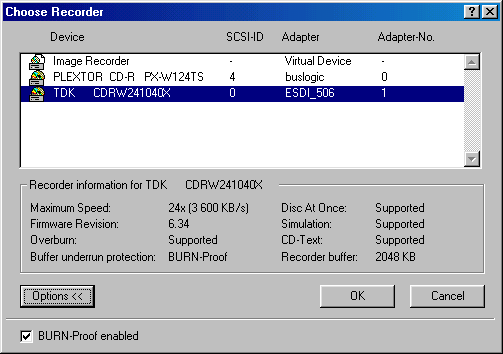 In course of testing of the recorder the buffer's load wasn't less then 90% even at 24X recording speed. 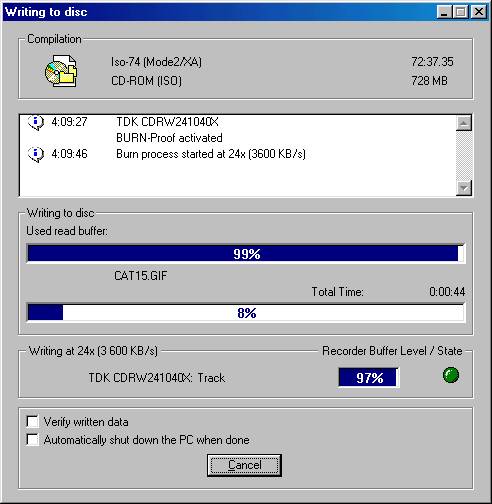 At the end the Nero reports that the process is completed.  The design of the recorder hasn't almost changed. The front panel has a streamline form and a writing '24/10/40X' in the left bottom corner.  The drive can be installed both in vertical and horizontal positions with the help of two springs, like in the Plextor recorders. On the rear panel there is a Digital Audio Connector. We have tried it by connecting SB Live! 5.1 sound card. Test resultsWe have found a new firmware version 6.35 for the recorder at the TDK's site. But the old version 6.34 was tested as well. It should be noted that it lacks for any rough bugs. But those tiny errors it had were fixed in the 6.35 version. For the performance comparison in reading operations, apart from the CD-ROM Teac 540E, we have chosen Plextor PX-W1610TA and Ricoh MP7200A. CDWinBench 99 CD-ROM Transfer Rate The TDK shares the second place with the Ricoh MP7200A. The firmware update boosts up the performance significantly. 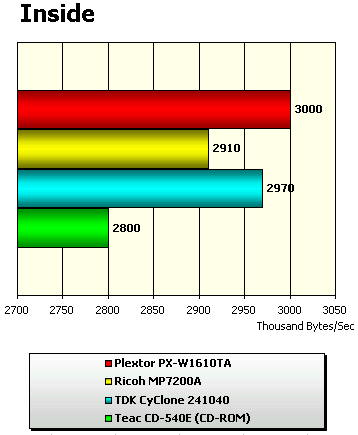 It's one of few cases where the firmware update greatly contributes in the performance raise. 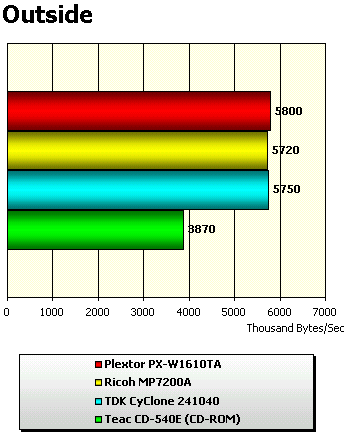 The results of all three recorders are identical. Now some words about a low performance of the TEAC CD-540E. It turned out that this CD-ROM TEAC drive can work flawlessly on VIA KT133 and KT133A based mainboards provided that the drive is set as a master on the primary IDE cable. Here is the graph of reading of the disc obtained with the CDSpeed utility. 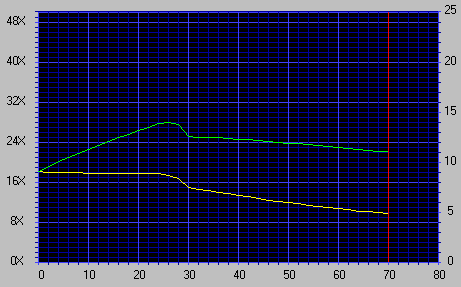 The results of the WinBench are low. For comparison we are giving here a graph which can be obtained when setting the CD-ROM TEAC as 'primary master': 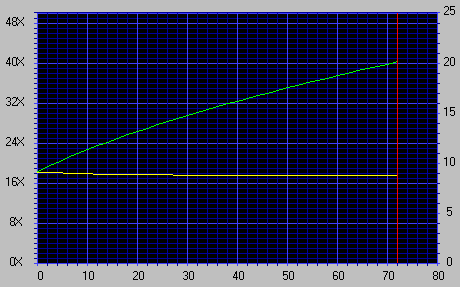 And here you can see a diagram of the Outside Transfer Rate test. 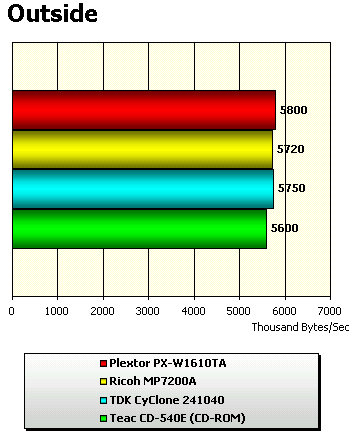 As you can see, the performance of the CD-ROM TEAC has much increased. All CD-RW drives show the performance higher than one of the fastest 40X CD-ROM drives. Other parameters such as internal data rate, access time and CPU utilization do not depend on the position of the drive, be it primary or secondary, master or slave. Later on we will be guided by exactly these results. The CPU utilization was:  In the previous tests of data transfer rate both CD-RW drives from Plextor and TDK were leading. That is why their CPU loading is very high. CDWinBench 99 CD-ROM Access Time The access time is a very important parameter. Unfortunately, the TDK recorder doesn't excel here. CDWinBench 99 CPU Utilization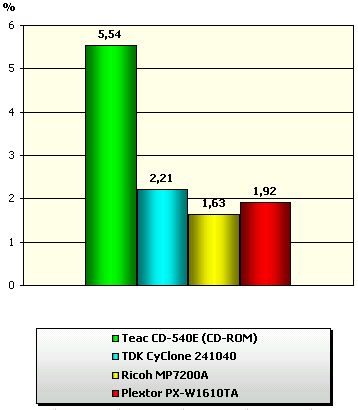 The CyClone's results are very close to that of the Plextor. The difference between 2.21% and 1.92% is not great, while 5.54% of the TEAC is too much. Time taken for CD recordingFor this test of the TDK recorder at 24X we used a CD-R TDK Reflex Ultra 24x disc, which is similar to the earlier used Philips Silver and Sony CDQ-74N1. That is why the results are comparable. The testing technique has changed a bit. Taking into account that the most of CD-RW drives ship in a Retail package with software from AHEAD, we decided to standardize a program test platform. The packet formatting and recording of CD-RW discs in a packet mode will be done under the InCD program, while CD-R discs will be recorded with the Nero program. Caching of files meant for recording will be activated in the Nero. Recording of the cyanine high-quality CD-R disc (Sony CDQ-74N1, TDK Reflex Ultra, Philips Silver Premium)
The recording takes only 4 minutes! Recording of the CD-R Mirex (phthalocyanine, 12x rated record speed)
Time spend by the TDK for recording of the Mirex phthalocyanine disc at 24X is definitely higher than it was spent for the cyanine CD-R Reflex Ultra. Most probably such results are obtained due to the FlexSS-BP technology. 16x write speed of the phthalocyanine disc was shown by the TDK recorder; it's a bit more than that of the PX-W1610TA. Recording of the "noname" CD-R (cyanine, the rated record speed is unknown) 4X
The TDK drive is a leader in this test. A low recording time at a low speed is a very important characteristic of a CD-RW drive since not everyone can afford to buy High-Speed CD-R discs. Time spent for full formatting of a CD-RW disc in UDF formatPhilips CD-RW 4x
Ricoh CD-RW 10x
The speed of operation of the CD-RW discs is not high. It's well seen for the AI-241040 especially at high speeds. Recording of a CD-RW disc (UDF)Philips CD-RW 4x
CD-RW Ricoh 10x
The CyClone in the record speed tests performed quite well. Both at 4X and 10X the TDK has only a bit lower results than that of the Ricoh. BLER factor of CD-R discs recorded with the Ricoh drive.
Here are the data for the Plextor PX-W1610TA:
(for these tests we used a device described in the fifth part of our review) The quality of burning is rather good. As the speed grows, the BLER factor increases as well. That is why for recording at 20X and 24X you should use high-quality media. In particular, it can be discs with a phthalocyanine active layer. Nero CDSpeedGraph of reading of the CD-R TDK Reflex Ultra (24x - write speed) 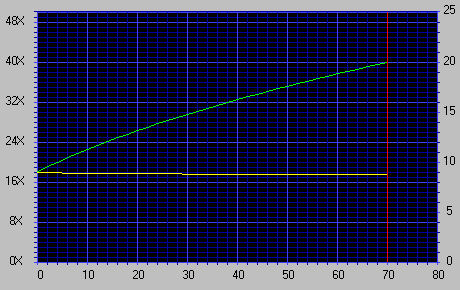 Graph of reading of the CD-R Sony CDQ-74N1 (16x - write speed) 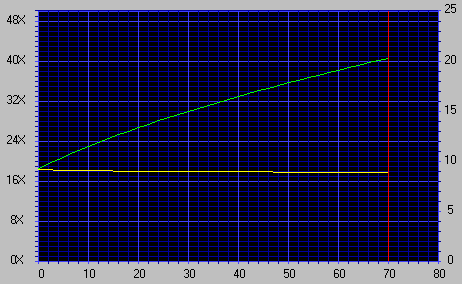 Graph of reading of the CD-R Mirex (24x - write speed)  Graph of reading of the CD-R Mirex (16x - write speed) 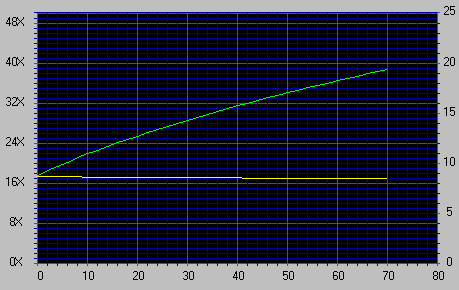 Graph of reading of the CD-R "noname" (4x - write speed) 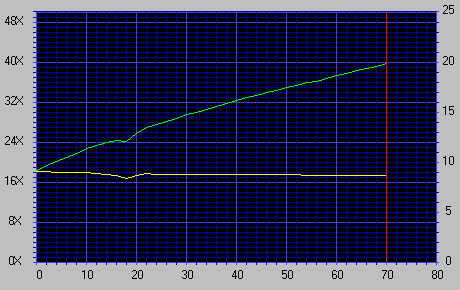 The graphs of reading are excellent, but for reading of the "noname" CD-R discs. CD Speed 99 test results of the recorded CD-R TDK Reflex Ultra (24X)
CD Speed 99 test results of the recorded high-quality CD-R discs (Sony CDQ-74N1, TDK Reflex Ultra, Philips Silver Premium).
CD Speed 99 test results of the recorded CD-R Mirex.
CD Speed 99 test results of the recorded CD-R Mirex.
CD Speed 99 test results of the recorded CD-R "noname."
On the whole, the TDK recorder performed quite well in the CDSpeed tests. Only in the test of disc load time the TDK doesn't shine: 12-15 sec according to the CDSpeed. With the 6.35 version this factor has reduced to 9-13 sec. CDSpeed results of the recorded CD-RW discs in UDF format.
The reading of the CD-RW disc by the CyClone is excellent. Rewritable discs in the ISO format are read at the speed just a bit lower than the results of testing of usual CD-R and CD-ROM media. CD-ROM Drive AnalyzerThe testing technique for the discs recorded with this utility has changed: "Chosen disk must not to be damaged. Testing can be performed then. Better, do this under Windows 95/98. (We do not enter in some specific details of testing under Windows NT here.)" The recorded discs were tested under the Windows 98. But the more correct results were given by the utility exactly under the Windows NT 4 and Windows 2000. That's why I use the latest firmware version - 2.31, where the recommended OS is NT. I will publish graphs of reading obtained under the Windows 98SE and Windows 2000 (Windows 2000 Pan-European Service Pack 2). Graphs of reading of CD-ROM Teac discs will be given only in case of need. Graph of reading of the recorded CD-R TDK Reflex Ultra (24X)Windows 98SE  Windows 2000  Graph of reading of the recorded CD-R Sony CDQ-74N1 (16X)Windows 98SE  Windows 2000 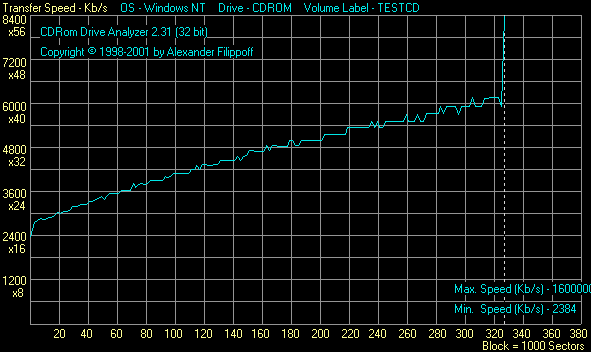 Graph of reading of the recorded CD-R Mirex (16X)Windows 98SE 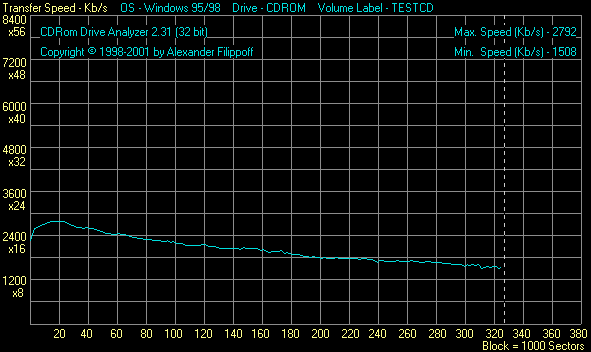 Windows 2000 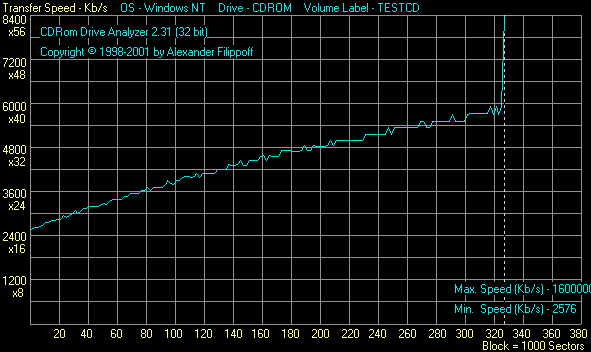 Graph of reading of the recorded CD-R "noname" (4X)Windows 98SE 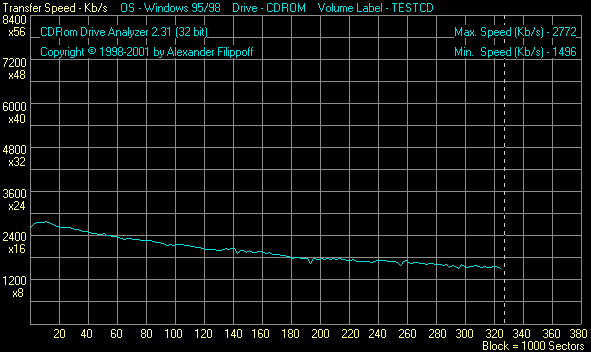 Windows 2000  Judging by the graphs obtained with the CD-ROM Drive Analyzer under Windows 2000, the speed and the character of reading are very good. The base microprogram of the v.6.34 had some problems with reading of phthalocyanine discs. So, here is the graph:  Ejecting of the disc and its repeated loading have improved the situation. The same situation occurred with the CDSpeed test program. After updating the firmware version of the program this problem was solved. Sound track extraction from audio CDs (CDDAE 99)
* - 4.28% means that the drive extracted 4.28% of the CD with errors. The extraction speed of the CD-RW drive of TDK is excellent. The last and the one but last tracks, according to the CDDAE 99, were copied onto the hard disc at 40, 9X. Sound track extraction from audio CDs (EAC 0.9 prebeta 11)
Advanced DAE Quality
The detailed information on the tested parameters are given in the help file to the CDSpeed99 test program. If you don't want to download the utility, then here you can find the HTMl help file. In all tested parameters the TDK AI-241040 gives extraordinary results. But the drive can't read data from Lead-In and Lead-Out. Overburn
Graph of reading of the recorded CD-R Rostok-CD In this test the TDK CyClone shows only average results. Direct copying from recorded CDs to a hard discCopying of the recorded CD-R Sony CDQ-74CN1
Copying of the recorded CD-R Mirex
Copying of the recorded CD-R "noname"
Reading of damaged CDs (Windows 98)TDK AI-241040"Golden" CD  Scratched disc 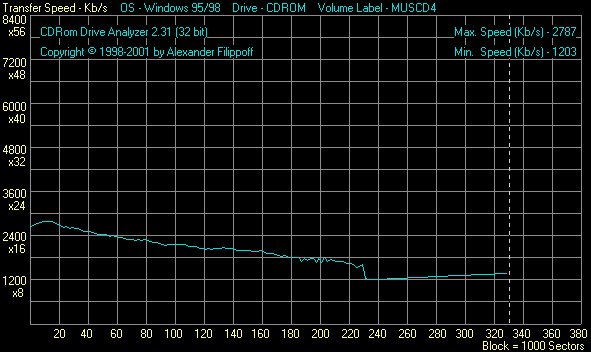 Under the Windows 98 the TDK recorder doesn't shine in reading of scratched discs. Testing in the Windows 2000 revealed the same layout - at the first hard-to-read area the speed fell to 10X (from 32X) but the test was finished at 12X. The damaged disc was read by 65%. Conclusion and summary.The new generation CD-RW drive from TDK contains a lot of improvements and new technological finds. As compared with the 16x model, this recorder doesn't make much noise. Discs ejected from the drive are a bit warm. The only I dislike is a long disc recognition time. This model will attract people who prefer everything new or who buy products with some reserve. The TDK AI-241040 will be interesting for those users who are keen on recording of Audio CDs at the speed not exceeding 2X. Besides, when recording audio CDs you will be pleased with the high track extraction speed. Are you ready to spend $280 for this device? If you are, then you will hardly regret it. Test programs:
Write a comment below. No registration needed!
|
| |||||||||||||||||||||||||||||||||||||||||||||||||||||||||||||||||||||||||||||||||||||||||||||||||||||||||||||||||||||||||||||||||||||||||||||||||||||||||||||||||||||||||||||||||||||||||||||||||||||||||||||||||||||||||||||||||||||||||||||||||||||||||||||||||||||||||||||||||||||||||||||||||||||||||||||||||||||||||||||||||||||||||||||||||||||||||||||||||||||||||||||||||||||||||||
Platform · Video · Multimedia · Mobile · Other || About us & Privacy policy · Twitter · Facebook
Copyright © Byrds Research & Publishing, Ltd., 1997–2011. All rights reserved.